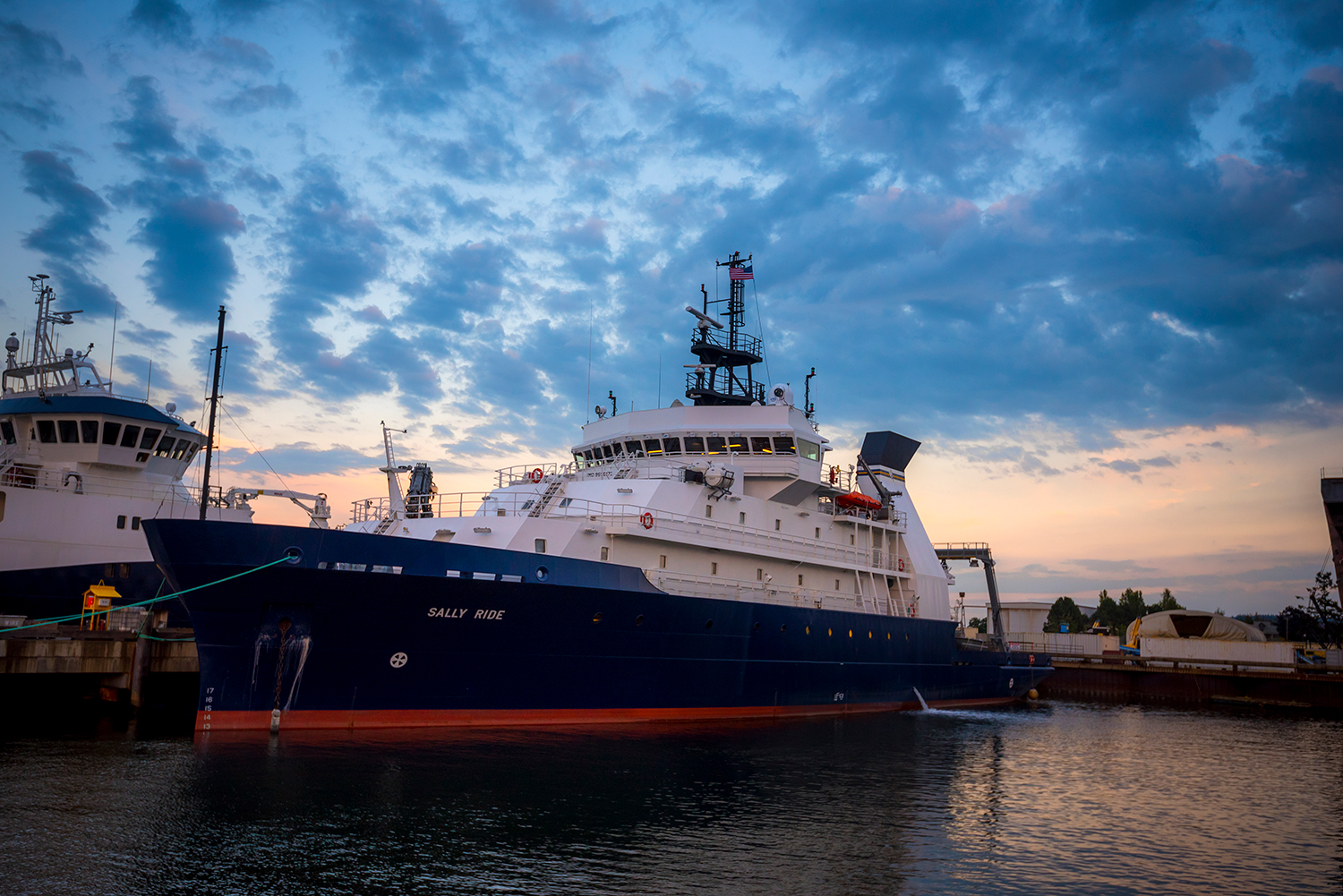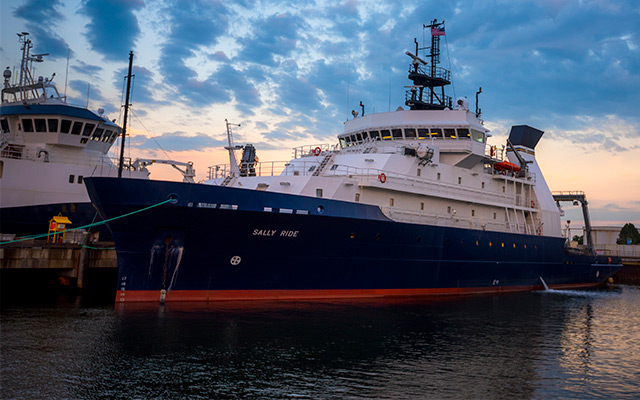
UC San Diego Hosts Free Tours of America’s Newest Scientific Research Ship R/V Sally Ride
By:
- Robert Monroe
Media Contact:
- Robert Monroe - scrippsnews@ucsd.edu
- Mario Aguilera - maguilera@ucsd.edu
Published Date
By:
- Robert Monroe
Share This:
Article Content

R/V Sally Ride. Photo: Erik Jepsen/UC San Diego Publications
The public is invited to free tours of America’s newest scientific research vessel, R/V Sally Ride, on Saturday, Aug. 20, from 1 p.m. to 4 p.m., as it docks at San Francisco’s famed Exploratorium interactive science museum for its first port call.
Owned by the U.S. Navy and operated by Scripps Institution of Oceanography at the University of California San Diego, the ship is one of the most technologically advanced oceanographic research vessels in the world. The vessel is named in honor of Sally Ride, the first American woman in space.
Small-group tours will take place at Pier 17 on the Embarcadero, adjacent to the Exploratorium. Tours, available on a first-come, first-served basis, will cover the vessel’s bridge, decks, research laboratories and other features. Tours are free but require tickets, which will be available at the east end of Pier 15 starting at 11:30 a.m. on the day of the event. Capacity is limited to 20 visitors per tour. All ages welcome. Tours will begin every 10 minutes, and last approximately 30 minutes.
Scientists from Scripps Oceanography will be on hand to describe the advanced technology of R/V Sally Ride and its mission of facilitating research that will help solve some of the planet’s most pressing challenges, from climate change to human health to natural disasters.
“As one of the world’s top public research universities, UC San Diego pushes the frontiers of knowledge through exploration and discovery, and advances science for the benefit of humankind,” said Chancellor Pradeep K. Khosla. “The research vessel Sally Ride will allow us to address our planet’s most pressing challenges and ensure that our oceans and atmosphere are preserved and protected for generations.”
Aboard R/V Sally Ride, seagoing scientists will embark upon a new journey of exploration and boundary-breaking—conducting research to find new compounds from the sea that can be developed into life-saving drugs, enhance our understanding of the consequences of human-caused global warming, protect our global food supply, and more.
R/V Sally Ride is the latest example of the long history of collaboration that brings together the bold exploration of Scripps Oceanography, one of the world’s top ocean and earth systems research centers, with the vision of the U.S. Navy and the Office of Naval Research. The new research vessel will provide “environmental intelligence”—knowledge to aid the planet and its inhabitants in a time of environmental crisis—which will have strategic value for national security and unique benefits for the State of California.
Following the limited Bay Area stop, R/V Sally Ride will continue on to its home port of San Diego, departing San Francisco on Aug. 22 and arriving at the Nimitz Marine Facility in Point Loma in San Diego, where the Scripps fleet is housed, on Aug. 26. A series of public events in San Diego is planned for October.
“I am very pleased to see R/V Sally Ride arriving in San Diego,” said U.S. Navy Chief of Naval Research Rear Adm. Mat Winter. “Scripps Institution of Oceanography has played a key role in Navy science and technology for over 70 years. In a world tightly knit by seagoing commerce, the Navy's understanding of the oceans underpins our ability to keep those sea lanes safe. The Sally Ride will enable generations of scientists to make new discoveries and to advance our knowledge of the world's oceans.”
Working to achieve new breakthroughs about California’s ocean resources, Scripps researchers will leverage science at sea for a new understanding of overfishing impacts, marine life populations, and management of food supplies to feed growing human populations. Such data support California’s economic interests by preserving industries that support jobs and tourism.
“So many aspects of critical ocean research can only be done on ships and that’s what makes the addition of R/V Sally Ride to our fleet so exciting,” said Scripps Director Margaret Leinen. “The ship is a technological marvel. And for Scripps Oceanography it comes just in time for us to observe accelerating changes in nature that we need to understand for the benefit and protection of society.”
R/V Sally Ride’s first scheduled research cruise in November 2016 will continue a 65-year tradition for the California Cooperative Oceanic Fisheries Investigations (CalCOFI) program to create predictive models for better management of California’s marine life resources. A current goal of the program is to create forecasts, not just of cyclical climate phenomena such as El Niño, but of the changes in marine life that are associated with those phenomena.
“Sally Ride is an Ocean Class research vessel, designed to conduct multidisciplinary research across the entire Pacific Ocean,” said Scripps Associate Director Bruce Appelgate, who leads the institution’s Ship Operations and Marine Technical Support. “With support from federal agencies such as the Office of Naval Research and the National Science Foundation, Sally Ride will enable scientists from across America to efficiently conduct high-quality research anywhere in the Pacific. As a teaching and research platform, this outstanding vessel provides us with the ability to study societally-relevant scientific issues that are important to all Americans, indeed to people worldwide, now and for decades to come.”
The U.S. Navy announced that Scripps Institution of Oceanography had been chosen as the operator of the vessel in 2010. After U.S. Congress authorized $89 million in the Department of Defense budget for the construction of the ship, Secretary of the Navy Ray Mabus announced that he had selected Sally Ride as the namesake of the new vessel. The ship became the first within the University-National Oceanographic Laboratory System (UNOLS), the consortium of U.S. academic centers that coordinates ship-based field research, to be named after a woman.
Ride was the first American woman in space and a member of the UC San Diego physics faculty. She made history in 1983 when she became the first American female astronaut to travel to space aboard Space Shuttle Challenger. In 1989, she joined the UC San Diego faculty as a professor of physics and served as director of UC’s California Space Institute from 1989 to 1996. She died on July 23, 2012, at the age of 61.
Over the course of the past hundred years, Scripps has operated more than 27 oceanographic research ships that have steamed more than 6 million nautical miles in support of science. Traveling on Scripps research vessels, scientists have sailed to tropical islands and ventured under polar ice, observing environments and their inhabitants, collecting specimens and samples, and recording volumes of data for laboratory analysis.
To learn more about upcoming tours of R/V Sally Ride, please visit https://scripps.ucsd.edu/ships/sally-ride.
Share This:
You May Also Like
Stay in the Know
Keep up with all the latest from UC San Diego. Subscribe to the newsletter today.



